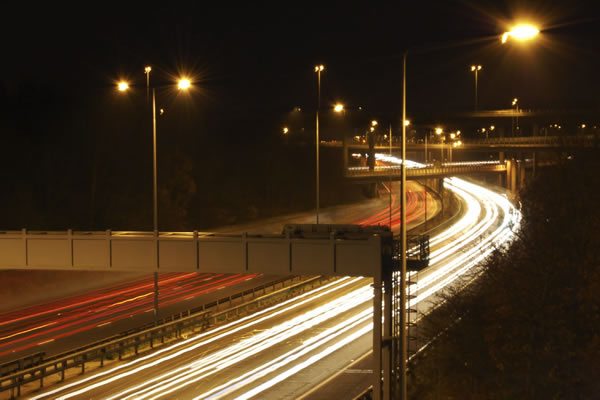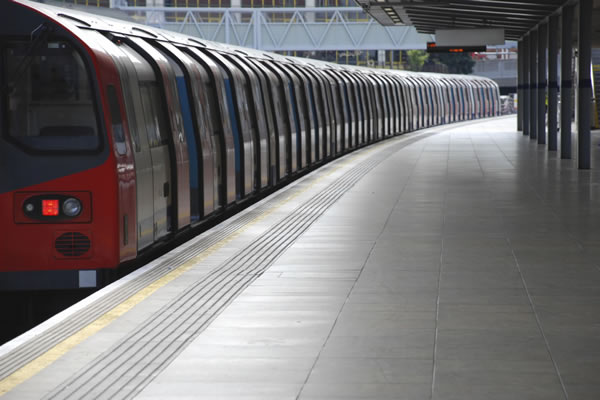How are Vehicles Detected at Traffic Signals?
Vehicle Detection at Traffic Signals will either be by an inductive loop system buried in the carriageway, above ground units mounted above signal heads or a pedestrian push button demand.
Inductive Loops
Contrary to popular belief, carriageway loops do not work off the pressure of vehicles passing over them but they are in fact inductive loops which work by detecting metal objects (such as vehicles) that pass over them. Vehicles passing over the loop causes a change in the magnetic field that is induced in the loop for the time taken for the vehicle to pass over the loop. This change in magnetic field causes a pulse which registers as a vehicle demand in the controller.

At some installations where vehicle speeds are high, a pair of loops can be used to determine approach speeds and appropriate action can be taken at the junction. For example if approach speeds are above a preset threshold then the intergreens will be increased to give additional safety measures for conflicting traffic.
Loops can also be used to call right turn indicative arrows. These work by detecting vehicles waiting on the loops and hence generating a constant change in the magnetic field in the loop. Once a vehicle has been sat on the loop for a preset time (usually 4s), a demand for the right turn is registered in the controller. If the vehicle moves off (by turning in a gap) then the demand is cancelled when the loop has been unoccupied for a preset time (usually 2s).
The same principle can also be applied to all red loops within junctions where waiting traffic (often right turners without the benefit of a right turn indicative arrow) registers a demand and the junction is held at all red for a specified period of time to allow the turning traffic to clear.
Above Ground Detection
Microwave detectors are usually mounted on top of signal poles and vehicles can be detected anywhere within the field of vision as long as the vehicle is travelling faster than 2-3mph. In cases where a slow moving queue occurs the approach should also have a loop at the stop line to ensure that traffic is detected.
There are numerous points that are considered when choosing between inductive loops and above ground detection. The installation and maintenance is easier and therefore cheaper for above ground detection and it cannot be dug up / damaged during road works. Inductive loops are not affected by adverse weather and cannot be obstructed by overhanging objects such as trees whereas above ground detection can be. The most appropriate type of detection must be selected on a site by site basis because what works for one site will not necessarily work for another.
Pedestrian Detection
Pedestrian detection now comes in many forms. There are the standard push button, which are combined with the red/green man display – these are associated with Puffin crossing facilities. Push buttons combined with a 'WAIT' symbol which extinguishes when the green man is shown are associated with the older form of crossing a PELICAN. Pressing the push button registers a demand with the controller which is then serviced in the same way as a traffic demand.
In addition to push buttons, kerbside and on-crossing detection is becoming more commonly used. Kerbside detection is focused on the pedestrian waiting area and is able to tell if a pedestrian has pushed the button and walked away or crossed before the green man is shown. It is then able to cancel the pedestrian demand so as to not waste pedestrian green time which could be better used by vehicles. Once on a puffin or toucan crossing, the on-crossing detectors monitor the progress of pedestrians across the crossing and extend the traffic red as necessary to ensure the pedestrian crosses the road before traffic starts running again. This can be particularly useful when there is a range of pedestrians crossing the road throughout the day who all take variable amounts of time to cross the road.
Require Traffic Signal Design Services?
Sanderson Associates have enjoyed over 37 years in business, our Traffic Signal Design Team have extensive experience in assisting our Clients with their Traffic Signal Design requirements for a wide variety of major and minor developments throughout the whole of the UK, Isle of Man and Ireland.
We would be pleased to provide you with our competitive fee proposal for our Traffic Signal Design Services, please call us on 01924 844080 or click here to complete our secure online form.



